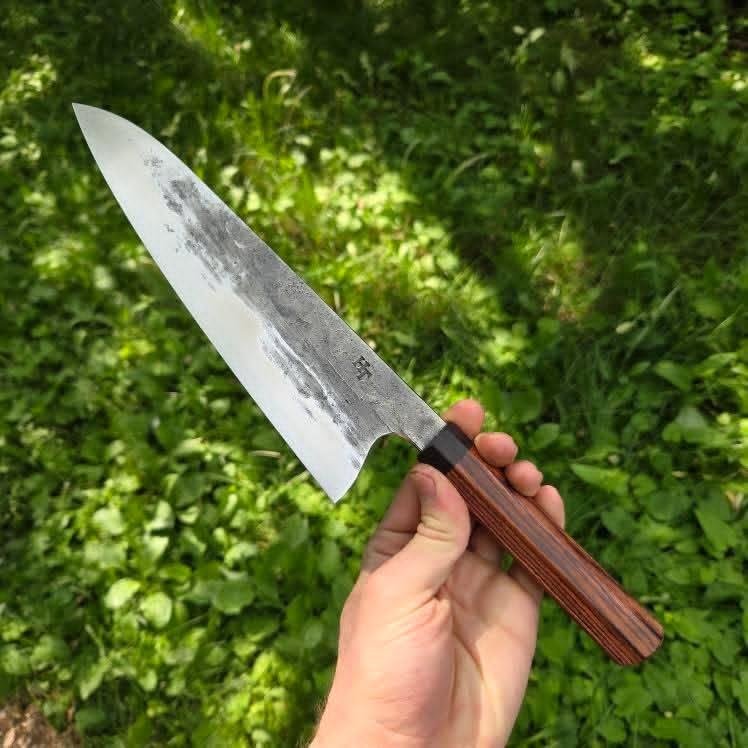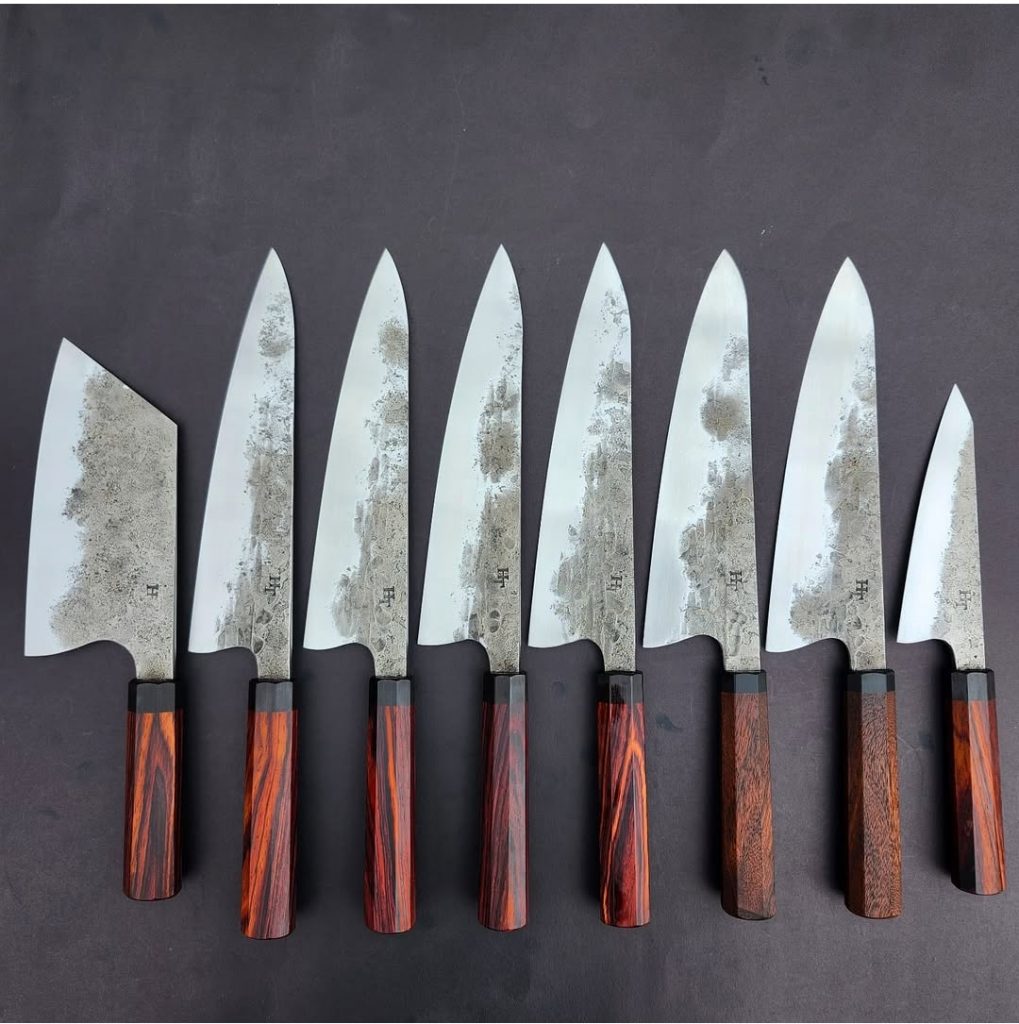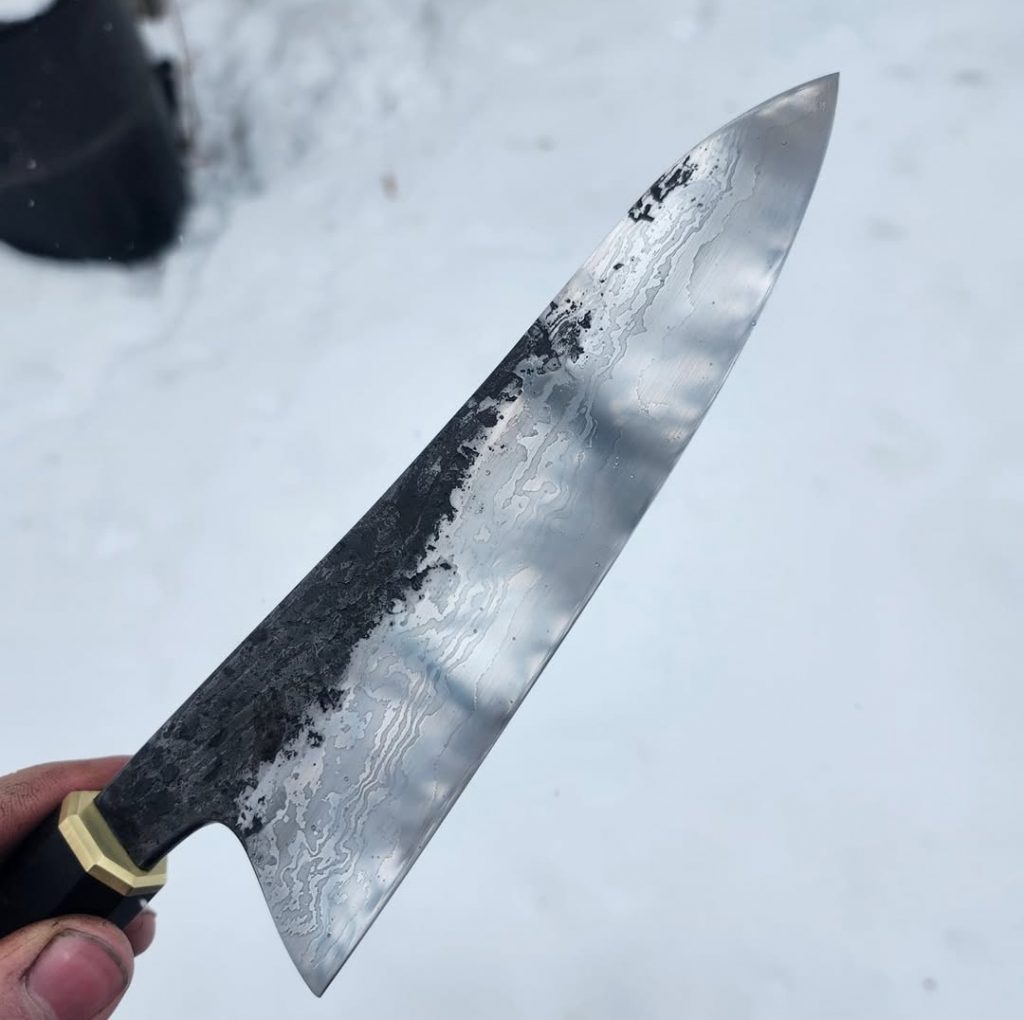
In this week’s interview, we return to Calgary, Alberta in Canada. Here we have a young and talented knifemaker named Hudson Torrens. The word that kept coming to my mind was hunger. His hunger for knowledge, and how that translates into taking more and more information in from a wide variety of makers. And in a similar way to physical hunger his mind takes what it needs to grow and then is translated into work that is entirely his own. His knives certainly have a Japanese element to them, but with Western maker touches harmonizing in an exciting way. I am certainly excited to see where his hunger takes him.
What started your interest in Knives?
I have been interested in blades since I was very young. I was very interested in martial arts and weapons. I think it was grade 3 when I bought a book about swords from different parts of the world. Another thing that really sparked my interest in making knives was the campfire. I would always find random pieces of metal, stick them in the fire and watch them turn red. From there I would even try to forge them on the rocks around the fire.
When did you start making knives?
My first finished knife was made in late 2020. I made a mild steel throwing knife before then but I don’t really count that one as it’s not what I do now. Besides, it was just a random piece of flat bar that I ground a tip on with a bench grinder.
What did you make your first knife with?
O1 tool steel G10, and a whole lot of hand filing. Me and my cousins bought an angle grinder, files, and O1 that we found at a store in our city. From there, we spent a whole weekend cutting the profiles out of the bar and filing them to shape. The most time-consuming part was filing in the bevels, all by hand. It took the majority of two days to file those with the quality of files we had, then it was probably another 20 hours or so to finish the rest of the knife and make the handle.
What is the most important aspect of a well made knife?
That’s a hard question. So many aspects of a knife are vital for it to be well made, and without one the others are less important. But I think the most important aspect is how much you enjoy using it.
What kind of knives do you make?
I specialize in culinary knives and mainly make Gyutos.

How did your background affect your approach to knives?
When I was apprenticing for Chris Green, I would always start a lot of different projects and try out new ideas, but I often didn’t finish them. Once I started on my own, I wanted to switch to making kitchen knives instead of outdoor knives. To keep things efficient I decided to make my knives in batches, this way I can improve my skills on something that maintains some consistency. This is also nice because if you make a batch and one knife cracks, it’s frustrating, but not a huge deal. However, if you are working on a custom knife with specific dimensions and steel that gets a lot worse. Now you have to make that again, but it might not be something you have the consistency down on.
Who helped you early on?
When I first started making knives, when I would finish one I would take it to Knifewear to show them and ask for advice. One day, when I went there one of the staff told me about another bladesmith in Calgary, Chris Green. I sent him a message to see if I could come by his shop and ended up apprenticing with him for a few years while I was in High School. That really helped me gather more skills and get exposure to different equipment and techniques. Also, a huge help was from Ben Kamon. After I moved into my own space and was starting to make kitchen knives full time, I was having a difficult time with the heat treating. So many of my knives were warping because I didn’t know how to heat treat thin knives. So, I sent Ben a message on Instagram because I really admired his work and he responded with a bunch of voice messages that really explained his processes and what might be going wrong with my knives. After that I changed my processes and started getting much better results.

Biggest struggle?
Something I find pretty difficult is to maintain a good work life balance when I am doing a large order of batch knives. If it’s running late because of warps, pretty often I end up working long hours every day until it’s done. Also a lot of struggles in my knife making come from my current workspace inefficiencies and lack of equipment. The space doesn’t have enough power for more equipment so I can’t fix the inefficiencies unless I find a new space.
What keeps you going?
I love to create. I always need to be working with my hands and mind together. I have to keep things interesting by always trying to improve in certain aspects. Sometimes it’s pretty difficult to get through a big batch that isn’t going well, but I am always trying to learn from every experience and use that towards the next one. Sometimes I take a step back and remember that I get to create for a living, and it also has taken me around the world, and those are very important things to me.
Any specific knife makers impress or inspire you?
Ben Kamon, Simon Krichbaum, Martin Huber, Tome Fenes, Antione Kniamen, Timo Verschuren, Edward Mayhew, and so many others. So many people are doing amazing work, and it provides a lot of inspiration.
Any specific breakthroughs?
Redesigning my heat treatment after getting help from Ben (Kamon) was huge. Also, my trip to Europe was a great breakthrough in so many ways. I learned so much and met so many amazing people. That really helped me get more involved in the knifemaking community and get my name out there so I could connect with more customers.
What is the perfect knife?
I think the perfect knife is the one you enjoy using the most. Ideally that would also be a knife that is very fine tuned in every aspect. Great geometry, steel, heat treat, comfort, and look super cool.

How do you approach knife testing?
Making test knives when I do a new design to test out small variations in the same profile. Also, throughout my knifemaking career I have been sending knives to chefs to test out and get feedback on. I usually do this when I make a design change, like steel, profile, or geometry. It has been super helpful to get input from the people that use them every day.
How do you design a knife and fine tune heat treat?
For my regular knives, I always start with the same size piece of steel. When I want to try a new design I will work out the new forging with a small batch of test knives. From that I will forge to the geometry I am going for, then I will shape the profile to best fit the forged in geometry. Currently all my forging is completely by hand. I choose the steel based on the performance I can get out of it, for a good price, and something that isn’t too hard to work on. I am really impressed with Procut because it has a great balance of all those properties and I think I can get more performance out of it than 52100. To develop the heat treat I always start at reading the knifesteelnerds article on the steel and heat treatment options. From that I will test out the Ideal heat treat for the performance I am trying to achieve, then adjust from there if needed. I also combine some things I have learned from other makers to help with the heat treatment process. Nothing to change the heat treat itself, but methods and specific timing to minimize warping. Then the grind I design to fit the forged in Geometry and aim for the highest performance I can achieve for each blade.
What’s up next for you?
I will be continuing to refine my knives and processes. I would like to get some equipment, like a power hammer eventually, but I’m not sure when that will be. Soon I am going to take a little break from batch knives to work on some interesting art knife ideas I have. And I am planning to do another big Europe trip this winter. I met so many amazing makers at Knifeshow Austria and got so many shop invites. So I want to go back to work with many more makers over the winter. So, my last batch of my regular knives from my home shop will probably be in October, and there likely won’t be another one until June 2026.
For more information and to see more of his work head over to his website https://hudsontorrensknives.com/ or his Instagram https://www.instagram.com/handmade.by.hudson/
Leave a Reply